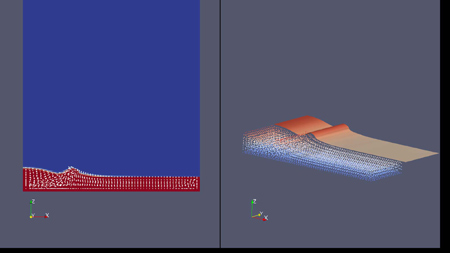Slosh simulation
In the highest echelons of motorsport every system on a car is optimised to the greatest possible extent. For example, the volume of lubricant carried is pared to the minimum in order to reduce overall vehicle weight and the packaging requirements of ancillaries such as oil tanks. These packaging requirements also mean that the shape and structure of oil tanks will not always be the dictated solely by the need for consistent oil supply. Extensive work is therefore undertaken to simulate the movement of oil within a tank under high g-loadings in order to ensure pick-ups and returns are correctly located.
The matter of fluid movement within enclosed spaces has been the subject of a great deal of study in a number of areas outside motorsport, notably in the marine industry and among mainstream automobile manufacturers. The first efforts at reliably simulating the behaviour of oil in tanks was in fact undertaken to understand its movement within bulk crude carriers in rough seas - in essence giant oil tanks!
Advances in modern CFD/FEA capability and high-performance computing systems mean it is practical now for racecar designers to incorporate slosh simulation (encompassing any fluid tanks, not simply oil) into the overall design process. This reduces the need for physical testing and reduces the chances of component failure on track due to oil starvation, while also allowing the behaviour of fluids to be taken into account in relation to a car's dynamic behaviour.
The interaction between a fluid in a tank, the tank and any air within the tank is a very complex one, and it is only recently that commercially available CFD/FEA packages have been capable of simulating such interactions. The two key methods used to simulate conditions are VOF (volume of flow) and arbitrary Lagrangian-Eulerian (ALE) formulations, both of which are able to account for the interactions between material and fluid as well as the boundary flow conditions on the surface of the fluid.
The VOF method is a numerical technique for tracking and locating the fluid-fluid interface. It belongs to the class of Eulerian methods that are characterised by a mesh that is either stationary or is moving in a certain prescribed manner to accommodate the evolving shape of the interface. As such, VOF is an advection scheme - a numerical recipe that allows the programmer to track the shape and position of the interface, but it is not a standalone flow-solving algorithm; the Navier-Stokes equations describing the motion of the flow have to be solved separately.
Several commercial CFD packages integrate VOF capability, although it is only in the past few years that the ability to conduct true VOF simulation has been incorporated into them. VOF methods are very effective for calculating the behaviour of fluids but are limited to this role, so if other factors such as heat transfer from the fluid to container material need to be studied, a different set of codes is needed. This is of particular note in racecar design, where items such as the oil tank can be packaged very closely to other components, where heat transfer could be an issue.
It is here that newly developed codes based around an ALE method can prove very beneficial. The ALE is a finite element formulation in which the computational system is not fixed in space as with the Eulerian-based VOF, or attached to material as in Lagrangian-based finite element formulations. When using the ALE technique in engineering simulations, the computational mesh inside the domains can move arbitrarily to optimise the shapes of elements, while the mesh on the boundaries and interfaces of the domains can move along with materials to precisely track the boundaries and interfaces of a multi-material system.

While very effective for fluid movement simulation, the big advantage of ALE-based finite element formulations is their ability to be reduced to either Lagrangian-based finite element formulations by equating mesh motion to material motion, or Eulerian-based finite element formulations by fixing the mesh in space. This means that only one FEA code is needed to perform the range of simulations from fluid flow and fluid-structure interactions through to heat transfer.
Such capability is not widely available in commercially produced packages, but this is likely to change soon. Whichever approach is chosen, it is now well within the abilities of teams with a good computing capability to accurately assess the behaviour of fluids throughout the vehicle and optimise designs to ensure that the performance or reliability of systems is not compromised.
Fig. 1 - Fluid slosh simulated in OpenFoam, a feely available open source simulation package
Written by Lawrence Butcher